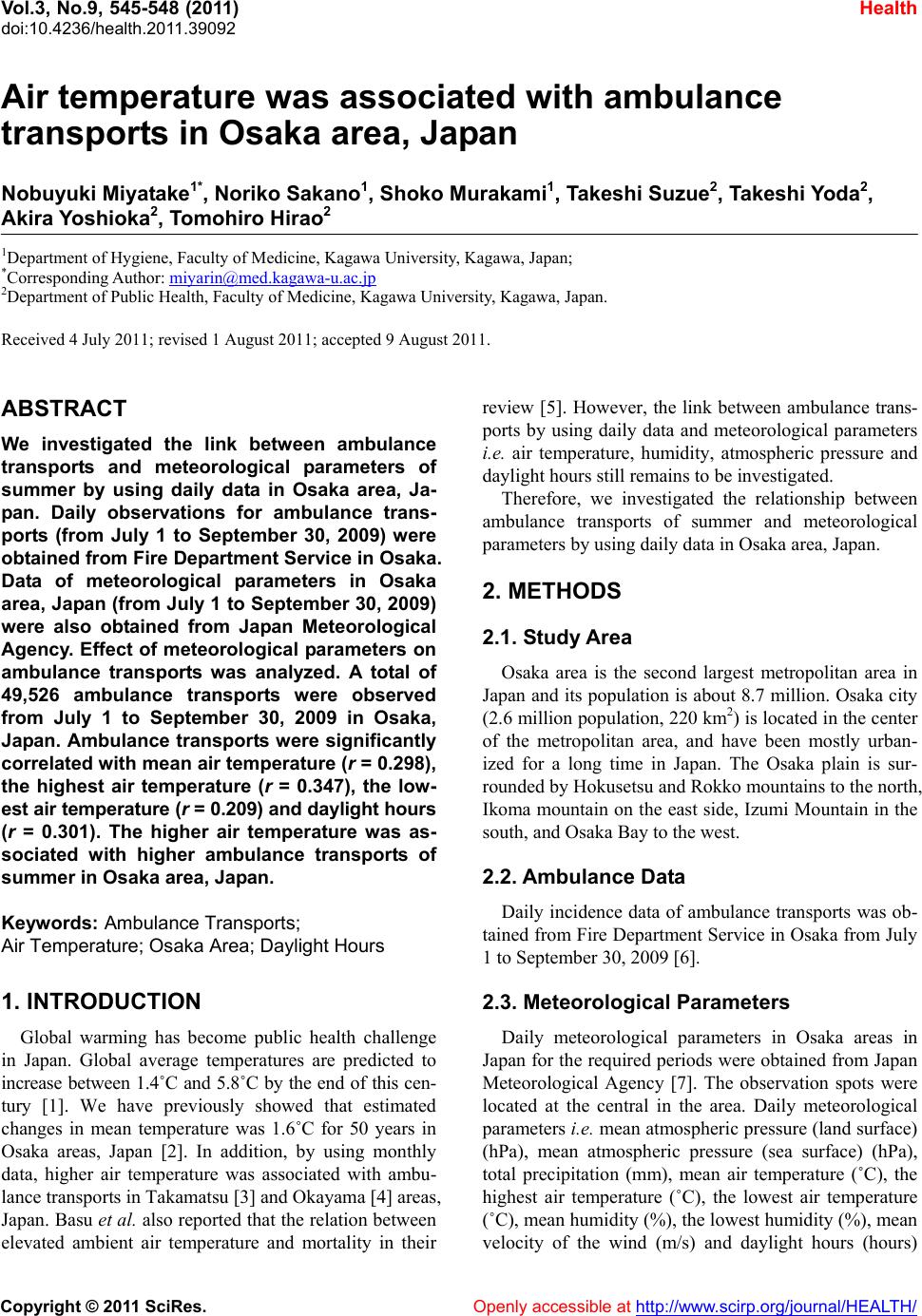
Vol.3, No.9, 545-548 (2011)
doi:10.4236/health.2011.39092
C
opyright © 2011 SciRes. Openly accessible at http://www.scirp.org/journal/HEALTH/
Health
Air temperature was associated with ambulance
transports in Osaka area, Japan
Nobuyuki Miyatake1*, Noriko Sakano1, Shoko Murakami1, Takeshi Suzue2, Takeshi Yoda2,
Akira Yoshioka2, Tomohiro Hirao2
1Department of Hygiene, Faculty of Medicine, Kagawa University, Kagawa, Japan;
*Corresponding Aut hor: miyarin@med.kagawa-u.ac.jp
2Department of Public Health, Faculty of Medicine, Kagawa University, Kagawa, Japan.
Received 4 July 2011; revised 1 August 2011; accepted 9 August 2011.
ABSTRACT
We investigated the link between ambulance
transports and meteorological parameters of
summer by using daily data in Osaka area, Ja-
pan. Daily observations for ambulance trans-
ports (from July 1 to September 30, 2009) were
obtained from Fire Department Service in Osaka.
Data of meteorological parameters in Osaka
area, Japan (from July 1 to September 30, 2009)
were also obtained from Japan Meteorological
Agency. Effect of meteorological parameters on
ambulance transports was analyzed. A total of
49,526 ambulance transports were observed
from July 1 to September 30, 2009 in Osaka,
Japan. Ambulance transports were significantly
correlated with mean air temperature (r = 0.298),
the highest air temperature (r = 0.347), the low-
est air temperature (r = 0.209) and daylight hour s
(r = 0.301). The higher air temperature was as-
sociated with higher ambulance transports of
summer in Osaka area, Japan.
Keywords: Ambulance Transports;
Air Temperature; Osaka Area; Daylight Hou rs
1. INTRODUCTION
Global warming has become public health challenge
in Japan. Global average temperatures are predicted to
increase between 1.4˚C and 5.8˚C by the end of this cen-
tury [1]. We have previously showed that estimated
changes in mean temperature was 1.6˚C for 50 years in
Osaka areas, Japan [2]. In addition, by using monthly
data, higher air temperature was associated with ambu-
lance transports in Takamatsu [3] and Okayama [4] areas,
Japan. Basu et al. also reported that th e relation between
elevated ambient air temperature and mortality in their
review [5]. However, the link between ambulance trans-
ports by using daily data and meteorological parameters
i.e. air temperature, humidity, atmospheric pressure and
daylight hours still remains to be investigated.
Therefore, we investigated the relationship between
ambulance transports of summer and meteorological
parameters by using daily data in Osaka area, Japan.
2. METHODS
2.1. Study Area
Osaka area is the second largest metropolitan area in
Japan and its population is abo ut 8.7 million . Osaka city
(2.6 million population, 220 km2) is located in the center
of the metropolitan area, and have been mostly urban-
ized for a long time in Japan. The Osaka plain is sur-
rounded by Hokusetsu and Rokko mountains to the north,
Ikoma mountain on the east side, Izumi Mountain in the
south, and Osaka Bay to the west.
2.2. Ambulance Dat a
Daily incidence data of ambulance transports was ob-
tained from Fire Department Service in Osaka from July
1 to September 30, 2009 [6].
2.3. Meteorological Parameters
Daily meteorological parameters in Osaka areas in
Japan for the required periods were obtained from Japan
Meteorological Agency [7]. The observation spots were
located at the central in the area. Daily meteorological
parameters i.e. mean atmospheric pressure (land surface)
(hPa), mean atmospheric pressure (sea surface) (hPa),
total precipitation (mm), mean air temperature (˚C), the
highest air temperature (˚C), the lowest air temperature
(˚C), mean humidity (%), the lowest humidity (%), mean
velocity of the wind (m/s) and daylight hours (hours)